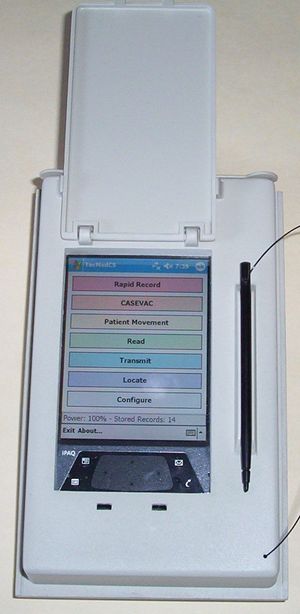The U.S. Navy believes RFID can help improve the treatment of causalities of war. In 2003, it tested the Tactical Medical Coordination System (TacMedCS), which employs a combination of RFID technology and satellite communications to track the condition and transport of wounded or deceased soldiers in the field. This is done via RFID-enabled wristbands, enabling medical personnel to better plan for incoming casualties (see RFID Tracked Casualties in Iraq).
The results of the two-month field test were largely positive, with all signs pointing to a wider, more permanent deployment. However, medical personnel found the handheld device housing the RFID reader and Iridium satellite modem to be bulky and difficult to manage, says Lieutenant Commander Carl Manemeit at the Marine Corps Warfighting Laboratory in Quantico, Va., which is now overseeing the project.
Given that feedback, ACC Systems, the Glen Head, N.Y.-based RFID hardware developer and integrator on the project, has returned from the drawing board with a smaller, more agile handheld device, called the ACC7100. Beginning in October, another medical battalion will test this device as it performs training operations in preparation for redeployment to Iraq. “They’ll train with them and run through casualty simulations,” explains Manemeit. “Then we’ll collect [the soldier’s] feedback.” If the assessment based on those comments is positive, the battalion may perform more testing in the theater of operations.
For the new handheld, ACC Systems decided to employ the Hewlett Packard iPAQ as the main computing element of the device, then build a cradle—or sled, as designers call it—into which the iPAQ slides. This sled contains an RFID reader module and Iridium satellite modem. The software needed to control the reader and satellite runs on iPAQ’s processor and was developed by ScenPro, a Richardson, Texas, firm that has been developing and integrating the TacMedCS system since its inception.
When the original version of the system was tested in 2003, wounded soldiers were issued RFID-enabled wristbands from Precision Dynamics Corp. (PDC). The band carries a Texas Instruments 13.56 Tag-It RFID inlay, which complies with the ISO 15693 and 18000-3 air-interface standards and has 2 kilobits of user memory. As each soldier was brought in for treatment, medics would encode that person’s identification number and medical condition, as well as any allergies or other pertinent information to the tag. This data was then sent via satellite to the central command.ELATED_ARTICLES For the tests of the new system, some soldiers will be issued RFID-enabled dog tags (carrying the same TI tag) encoded with their name, identification number, blood type and any other important medical information. In the simulations and, possibly, later real-world operations, the medics will read this data from the dog tags and encode that same information directly to the wristbands issued to the wounded soldiers. This automated process is expected to save time and reduce errors.
Like its predecessor, the ACC7100 contains a 9601 Iridium satellite modem. The original, bulkier handheld, however, used a 13.56 MHz interrogator module made by Sirit. But Victor Sackett, director of the RFID division at ACC Systems, says he was attracted to the compact size and performance of the SkyeTek MI module and decided to embed it into the ACC7100. The M1 measures 40 by 38 by 4 millimeters and can read inlays from 8.5 centimeters away, according to SkyeTek, based Boulder, Colo. Consequently, the new handheld is about 2 inches shorter and 1 inch thinner than the original, Sackett says, making it roughly 15 percent smaller and lighter.


